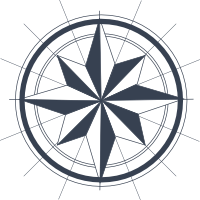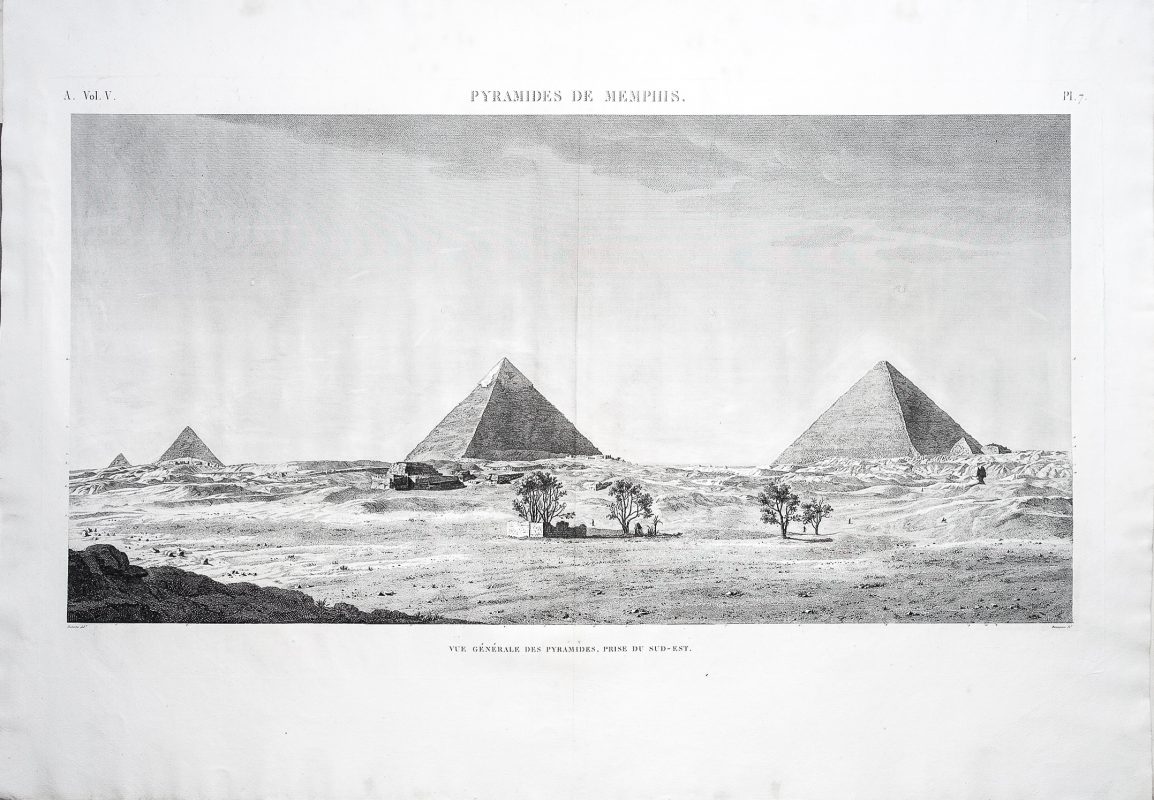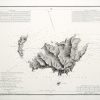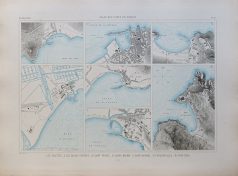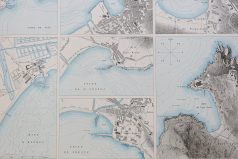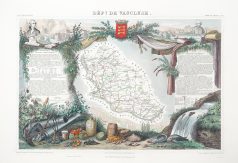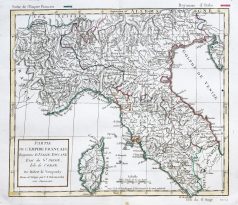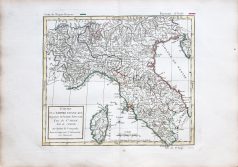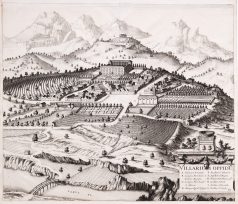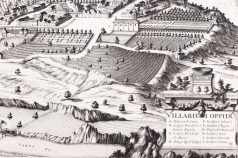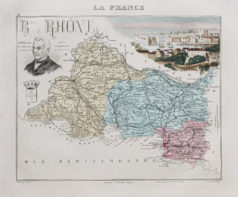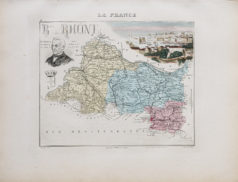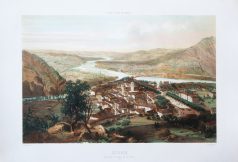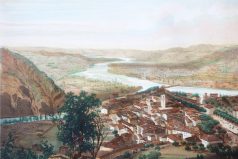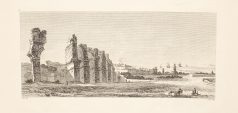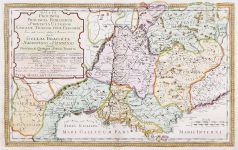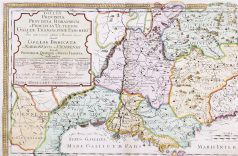La principauté d’orange – comtat Venaissin – Carte géographique ancienne de la Provence – Hondius – Originale Antique map
Épreuve originale gravée en 1638.
Beaux coloris anciens. Excellent état.
Texte en gothique explicatif au verso.
Superbe carte éditée en 1627 illustrant la région d’Avignon.
Format feuille : 53 x 43,5 cm.
Format Gravure : 51 x 39 cm.
Original antique map of 1638.
Vendu/sold
DEMANDE D'INFORMATION
Hondius
Jodocus Hondius, l’un des graveurs les plus célèbres de son temps, est connu pour son travail en association avec de nombreux cartographes et éditeurs importants à la fin du XVIe et du début du XVIIe siècle.
Né en Flandre, il grandit à Gand. Il fut apprenti dans une entreprise de fabrication d’instruments scientifiques, globes et gravure de cartes.
En 1584, pour échapper aux troubles religieux qui balayaient les Pays-Bas, il s’enfuit à Londres où il passa quelques années avant de s’installer à Amsterdam vers 1593.
De l’époque londonienne, il conservera les contacts qu’il avait noué avec les plus grands scientifiques et géographes du jour, auteurs de The Mariner’s Mirrour, l’édition anglaise de Waghenaer’s Sea Atlas. Nul ne doute que son exil temporaire à Londres lui fut utile, lui valant une réputation internationale, car ce n’est pas un hasard que John Speed célèbre cartographe anglais, choisit Hondius pour graver les planches des cartes du Théâtre de l’Empire de la Grande-Britaine entre 1605 et 1610.
En 1604, Hondius acheta les planches de l’Atlas Mercator qui, malgré son excellence, n’avaient pas réussi à concurrencer la demande persistante des cartes d’Ortelius.
Après la mort de Jodocus Hondius l’Ancien en 1612, ses travaux de cartographie et miniature, ont été confiés à sa veuve et à ses fils, Jodocus II et Henricus, puis à Jan Jansson à Amsterdam. Au total, à partir de 1606, près de 50 éditions comportant un nombre croissant de cartes avec des textes dans les principales langues européennes ont été imprimées.
Jodocus Hondius, one of the most notable engravers of his time, is known for his work in association with many of the cartographers and publishers prominent at the end of the sixteenth and the beginning of the seventeenth century.
A native of Flanders, he grew up in Ghent, apprenticed as an instrument and globe maker and map engraver. In 1584, to escape the religious troubles sweeping the Low Countries at that time, he fled to London where he spent some years before finally settling in Amsterdam about 1593. In the London period he came into contact with the leading scientists and geographers of the day and engraved maps in The Mariner’s Mirrour, the English edition of Waghenaer’s Sea Atlas, as well as others with Pieter van den Keere, his brother-in-law. No doubt his temporary exile in London stood him in good stead, earning him an international reputation, for it could have been no accident that Speed chose Hondius to engrave the plates for the maps in The Theatre of the Empire of Great Britaine in the years between 1605 and 1610.
In 1604 Hondius bought the plates of Mercator’s Atlas which, in spite of its excellence, had not competed successfully with the continuing demand for the Ortelius Theatrum Orbis Terrarum. To meet this competition Hondius added about 40 maps to Mercator’s original number and from 1 6o6 published enlarged editions in many languages, still under Mercator’s name but with his own name as publisher. These atlases have become known as the Mercator/Hondius series. The following year the maps were reengraved in miniature form and issued as a pocket Atlas Minor. After the death of Jodocus Hondius the Elder in 1612, work on the two atlases, folio and miniature was carried on by his widow and sons, Jodocus II and Henricus, and eventually in conjunction with Jan Jansson in Amsterdam. In all, from 1606 onwards, nearly 50 editions with increasing numbers of maps with texts in the main European languages were printed. Summaries of these issues are given under the entry for Gerard Mercator.
Produits similaires
Provence & Côte d'Azur
Les Salettes, les Salins d’Hyères, Saint-Tropez, Sainte Maxime, Saint-Raphaël, Porquerolles, Port Cros. Carte gravée en 1891. Belle impression en couleurs. Très bon état. Format feuille : 66 x 49,5 cm. Original antique chart of 1891. Rare collection illustrant les ports de France. Institution qui modèle le littoral français (1667 – 2000), dans la tradition des Neptune français.
Provence & Côte d'Azur
Carte originale gravée en 1860. Beaux coloris aquarelle. Très bon état. Format feuille : 53 x 36,5 cm. Célèbre édition du milieu du 19ème siècle publiée rue Saint Jacques à Paris, illustrée de commentaires sur les divisions administratives, curiosités, production, commerce et célébrités.
Partie de l'Empire français, Royaume d'Italie ; Toscane. Etat du Siège et Île de Corse. Epreuve originale gravée en 1805. Delamarche et Vaugondy géographes. Limites colorées de l’époque. Très bon état. Format feuille : 45 x 32 cm. Format gravure : 31 x 27 cm. Original antique map of 1805
Provence & Côte d'Azur
Epreuve originale gravée en 1693. Parfait état. Grand in-folio. Format feuille : 58,5 x 54 cm Format gravure : 57,5 x 49 cm. Original antique engraving of 1693. Superbe épreuve parfaitement imprimée à la fin du 17ème siècle dans l’imprimerie de la famille Blaeu.
Provence & Côte d'Azur
Carte géographique ancienne du département des Bouches-du-Rhône
Carte originale gravée en 1880. Beaux cartouches colorés à l’aquarelle. Très bon état. Format feuille : 34,5 x 26 cm. Original antique map of 1880. Edition de la fin du 19ème siècle illustrant les départements français et d’Outre-mer, agrémentée de vignettes aquarellées du chef-lieu, curiosités et personnages célèbres.
Provence & Côte d'Azur
Grande lithographie originale réalisée en 1850. Guesdon Dessinateur & Springer lithographe. Beaux coloris aquarelle. Très bon état. Format feuille : 57 x 40 cm. Original antique lithography of 1850. Rare lithographie de cette collection réalisée au milieu du 19ème siècle, montrant les villes françaises en prise de vue aérienne à bord de Ballon dirigeable.
Provence & Côte d'Azur
Épreuve originale gravée en 1805. Excellent état. Format feuille : 48 x 25 cm. Format gravure : 30 x 19,2 cm. Original antique engraving of 1805
Languedoc & Roussillon
Galliae Provinciae, Provincia Romanorum et Provincia ulterior Galliae transalpinae Pars meridionalis... Gallia Braccata Narbonensis et Viennensis... Epreuve originale gravée en 1723. Chez Pierre Moullart - Sanson. Coloris anciens. Belle épreuve à grande marge. Format feuille : 63 x 52 cm. Format gravure : 55,5 x 34,5cm. Orignal antique map of 1723. Très beaux coloris anciens pour cette carte peu courante illustrant les territoires méditerranéens occupés par les romains dans l’ancienne Gaule. Large cartouche de titre expliquant les provinces romaines.

